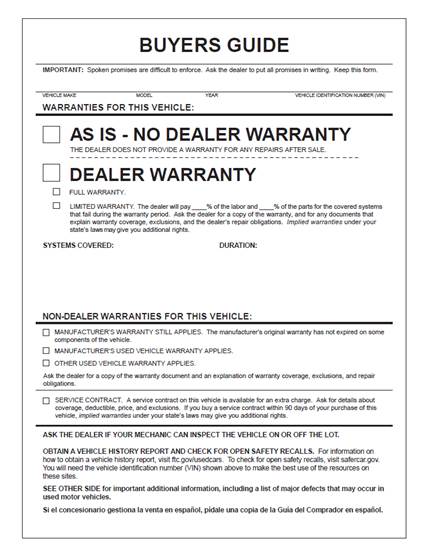What does the term "as-is" mean in a used car sale?
Definition of an "as is" transaction.
An “as-is” disclaimer in a used car sale transaction essentially communicates to the buyer that they are purchasing the vehicle in its current condition, without any warranties or guarantees from the seller. This type of disclaimer is highly effective and commonly used to limit the seller’s liability and protect them from potential legal claims or disputes related to the condition of the vehicle after the sale.
Here’s what an “as-is” disclaimer typically means and its effects:
- No Warranty: When a seller includes an “as-is” disclaimer, they are explicitly stating that they are not providing any warranties or assurances about the quality, functionality, or condition of the vehicle. This means that if any issues arise after the sale, the buyer cannot hold the seller responsible for repairs, replacements, or refunds.
- Inspection Responsibility: It is generally the buyer’s responsibility to thoroughly inspect the vehicle and assess its condition before finalizing the purchase. The seller may not be obligated to disclose all existing or potential problems with the vehicle.
- Limitation of Legal Recourse: By accepting an “as-is” sale, the buyer will have little to no recourse if they later discover issues with the vehicle that were not disclosed. This disclaimer is designed to protect the seller from potential lawsuits or claims related to defects or problems with the vehicle.
What cant a dealership disclaim?
While the “as-is” disclaimer reduces the seller’s liability, it doesn’t absolve them from intentionally concealing major defects or misrepresenting the vehicle’s condition. In some cases, if the seller knowingly hides serious problems, the buyer may still have legal grounds to challenge the sale. Such misrepresentations must be corroborated by written evidence of a misrepresentation- oral representations are exceedingly difficult to prove.
In addition to the above, an as-is disclaimer cannot be used to disclaim mileage tampering or the fact that the vehicle has a branded title.
How must a dealership provide an as-is disclaimer?
In addition to providing as-is disclaimers in the sales contracts for the vehicle, federal law requires that a dealership provide a used car buyer’s guide for every used vehicle it sells.
The FTC (Federal Trade Commission) Used Car Buyer’s Guide is a document required by law to be posted in the window of a used car offered for sale by a dealer. It provides important information for consumers considering purchasing a used car and aims to promote transparency and fair practices in the used car sales industry.
The Used Car Buyer’s Guide contains two main sections:
- Warranty Information: This section outlines the warranty coverage that the dealer is offering, if any. It categorizes the vehicle into three main categories:
- “As Is” – No Warranty: This indicates that the vehicle is being sold without any warranty. The buyer is responsible for any repairs or issues that arise after the sale.
- Implied Warranties Only: The dealer is providing certain implied warranties, which can vary depending on state laws. These warranties typically cover specific components for a certain period.
- Written Warranty: If the dealer is offering a written warranty, the details of the coverage, duration, and what is included should be clearly specified.
- Disclosure of Major Defects and Prior Use: This section highlights any major defects that are known to the dealer and may affect the safety, functionality, or value of the vehicle. It also indicates whether the vehicle has been used as a rental, leased, a fleet vehicle, or for other purposes.
The Used Car Buyer’s Guide helps potential buyers make informed decisions by providing them with essential information about the vehicle’s warranty status and potential issues. It’s important for buyers to carefully review this guide and understand the terms of the sale before purchasing a used car. A sample buyer’s guide is attached below for reference.


